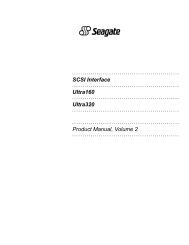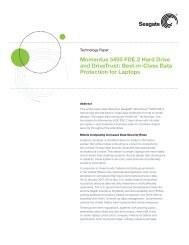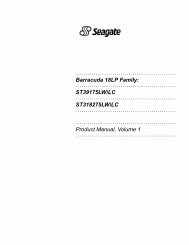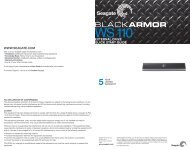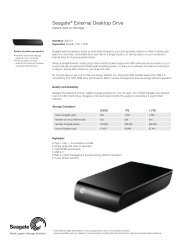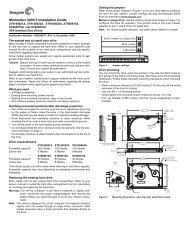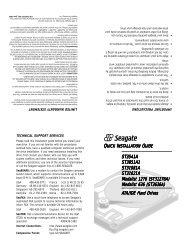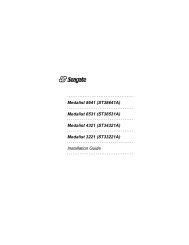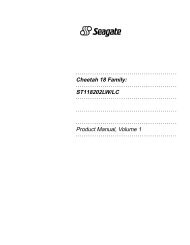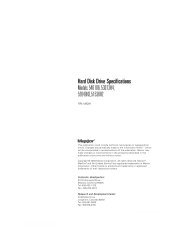Quickview 300 Product Manual PATA - Seagate
Quickview 300 Product Manual PATA - Seagate
Quickview 300 Product Manual PATA - Seagate
Create successful ePaper yourself
Turn your PDF publications into a flip-book with our unique Google optimized e-Paper software.
Breaking the 137GB Storage Barrier<br />
A.1.5<br />
What Else is Involved?<br />
Effort is required from OS vendors to increase storage device addressing<br />
up to 48 bits or more. This increase will be a significant challenge for<br />
many OS vendors that have 32-bit code models. Adapting to 48-bit<br />
commands will be easy, but most vendors will stop filling data at the 32-<br />
bit boundary and pad the upper 16 bits with zeros, leaving that space<br />
empty.<br />
The BIOS companies will also have to perform some work to recognize<br />
the increased capacity of the devices attached to the bus and allow the<br />
extended 48-bit commands to pass on to the devices. Boot partitions will<br />
also be an issue for the capacity of the drive if the BIOS does not<br />
recognize the 48-bit addressing scheme at or before the system boots the<br />
OS from the hard drive.<br />
Independent software driver efforts for legacy operating systems<br />
(Windows NT 4, Windows 98, and so on) will need to be implemented to<br />
allow higher-capacity devices to work on installed systems and recognize<br />
the maximum available capacity of the drive over the 137-gigabyte limit.<br />
A.1.6<br />
What is the Next Barrier?<br />
While it is true that the ATA/ATAPI-6 standard defines a method to<br />
provide a total capacity for a device of 144 petabytes, the next limit will<br />
be imposed not by the ATA devices but by many of the popular operating<br />
systems in use today. This limit will be at 2.2 terabytes (2,200<br />
gigabytes). This barrier exists because many of today’s operating<br />
systems are based on 32-bit addressing. These operating systems include<br />
many flavors of Linux, Mac OS 9.x, and Windows 95, 98, ME, NT 4,<br />
2000, and XP (Windows XP/64-bit also has the limit because of leveraged<br />
32-bit code).<br />
This barrier could be real as early as 2004 if current hard drive capacity<br />
rate increases continue along the same growth trends.<br />
Appendix A:<br />
Terminology<br />
• BIOS: (an acronym for Basic Input/Output System design):<br />
The BIOS processes and redirects all data as it is being<br />
accessed and stored.<br />
• FAT: (an acronym for File Allocation Table): The FAT tells the<br />
computer where data has been stored on the hard drive.<br />
• CHS: (an acronym for Cylinders, Heads, and Sectors): The<br />
basic layout components of a hard drive. INT 13h & INT 13h<br />
extensions: protocols used for accessing data on hard drives.<br />
A-4 <strong>Quickview</strong> <strong>300</strong> 80/100/120/160/200/250/<strong>300</strong>GB <strong>PATA</strong>



